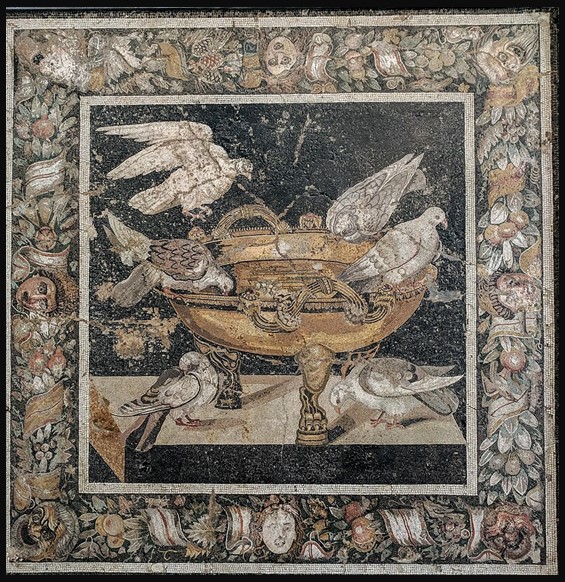
The dove, revered across cultures and religions, stands as a powerful symbol of Peace, Purity, and Hope. With its gentle demeanor and graceful flight, the dove has been a timeless emblem of tranquility and reconciliation. In various ancient mythologies, the dove has been linked to goddesses of love and fertility, like Inanna/Ishtar in Mesopotamia, or Aphrodite in Greece, adding a dimension of divine love to its symbolism. The dove’s appearance in the biblical story of Noah’s Ark further solidified its association with peace and new beginnings, as it returned to Noah carrying an olive branch, signaling the end of the flood. In Christianity, it gained prominence as a symbol of the Holy Spirit, often depicted during significant moments like the baptism of Jesus. Beyond religious contexts, the dove has become a universal icon for peace movements and humanitarian causes, transcending borders and languages to convey a shared aspiration for harmony in the world. As we usher in the New Year, let the beautiful mosaic of Doves in the House of the Doves in Pompeii serve as a heartfelt message for peace and prosperity in the coming year! May the spirit of these doves inspire moments of serenity and abundance in your life as we embark on this fresh journey together.
The House of the Doves (Casa delle Colombe or Casa di V. Popidius) is a captivating ancient Roman residence located in the archaeological site of Pompeii. Situated in the southwestern part of the city (Regio VIII, 2-34), this well-preserved house offers a glimpse into the lifestyle of the Pompeian elite during the first century AD. The house derives its name from a stunning mosaic that adorns one of its rooms (Room ‘n’ in Plan), featuring six Doves in various poses, around a water basin. Its layout is typical of Roman homes, with a central atrium surrounded by rooms adorned with frescoes, mosaics, and other ornate decorations. The architectural and artistic elements found within the house provide valuable insights into the aesthetics and daily life of Pompeii’s ancient inhabitants, making it a fascinating destination for archaeologists, historians, and visitors alike.
The intricate Mosaic Emblema featuring three doves perched on the rim of a golden water basin supported by lion’s feet, with a fourth dove gracefully descending and two more resting on the shelf below, is just one among the numerous exquisite details that distinguish this particular residence. Unearthed during the March 1885 excavation season in Room ‘n,’ an oecus or triclinium located in the southeast corner of the house’s atrium, the impressive mosaic is currently on display at the Naples Archaeological Museum. https://mann-napoli.it/en/mosaici-2/
The room’s floor, hardly preserved today, was made of a white mosaic with small tesserae without any border. In the center, the Emblema with the Doves is believed to derive from a model by the famed mosaicist Sosus of Pergamon (εκ Περγάμου ψηφιδογράφος Σώσος), an artist discussed and much admired by Pliny the Elder.
Sosus of Pergamon, a renowned Hellenistic mosaicist, left an indelible mark on the ancient world with his extraordinary mosaic artworks. Pliny describes Hellenistic mosaic making and Sosus’s accomplishments as …Paved floors originated among the Greeks and were skilfully embellished with a kind of paintwork until this was superseded by mosaics. In this latter field the most famous exponent was Sosus, who at Pergamum created a greatly admired mosaic of a Dove… in the act of drinking, and throwing the shadow of its head upon the water; while other birds are to be seen sunning and pluming themselves, on the margin of a drinking-bowl. https://www.perseus.tufts.edu/hopper/text?doc=Perseus%3Atext%3A1999.02.0137%3Abook%3D36%3Achapter%3D60
While none of Sosus’s original works have withstood the test of time, his renown persists through the admiration of later artists and historians. His impact on the art of mosaic has created a lasting legacy, inspiring subsequent generations and enriching the intricate tapestry of Hellenistic artistic achievement. The question arises: is the Pompeiian Mosaic of Doves a reproduction of Sosus’s renowned Hellenistic mosaic? An affirmative response is quite likely.
Wishing you a joyous and fulfilling New Year filled with Harmony and Happiness!
Behold, I send you forth as sheep in the midst of wolves: be ye therefore wise as serpents, and harmless as doves (Matthew 10:16)… https://www.biblegateway.com/passage/?search=Matthew%2010%3A16&version=NIV
For a Student Activity, inspired by the beautiful mosaic of Doves in the House of the Doves in Pompeii, please… Check HERE!
A reference to the legendary Hellenistic Mosaicist Sosus (εκ Περγάμου ψηφιδογράφος Σώσος), can be accessed in a former Teacher Curator BLOG POST titled Heraklitos and the Asarotos Oikos Mosaic… https://www.teachercurator.com/art/heraklitos-and-the-asarotos-oikos-mosaic/